The only problem was that I didn't have a tagine.
I mentioned this to a few friends, and almost all of them asked the same question: "What's a tagine?"
A tagine, like my Famous Covers Aunt May action figure, is a thing that exists.

Yes, you do, in all your horrifying glory.
Aunt May actually has nothing to do with this blog entry, but I had her out for another entry that I ended up not writing yesterday, so I figured, "What the hell. Let's go with it."
Anyway, a tagine is a Moroccan clay cooking pot, with a lid, in a very specific shape. Since you're already here, Aunt May, why don't you show it off?
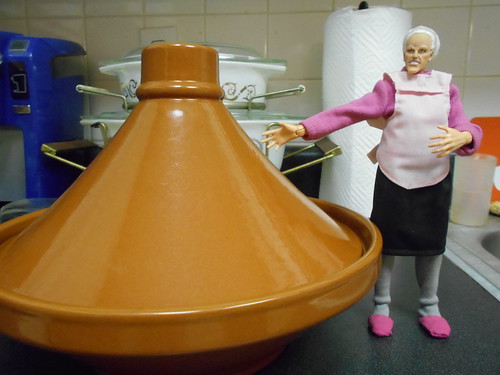

Jesus, that's enough of that. People are going to have nightmares.
They had tagines at Williams-Sonoma, where Richard and Laura got theirs, but they were $60 dollars. The one at the World Market was $20, so I went with that one and decided to give this whole thing a try.
First, I had to take the "tagine spices":

and toast them in a skillet pan for three minutes:

I have no idea what's in tagine spices, but they smelled really good when they were toasting. Once they were toasted, I mixed them in a bowl with salt, freshly ground pepper, minced garlic, and olive oil to create a paste:

that I then coated the raw chicken in:

The bowl of chicken, with some bay leaves added, went into the refrigerator for three hours to marinate, and when the three hours was almost up I got to work on the rest of the preparation. First, I had to slice up some fresh cilantro:
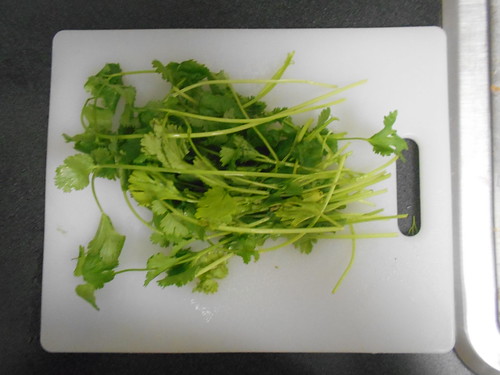
and Italian flat leaf parsley. Then I scooped out a cup of olives from the jar that was in the gift bag, and got out the jar of preserved lemons:

I've never worked with preserved lemon before, but it seemed easy enough. According to the recipe, I needed to rinse, then clear out the pulp:

and slice the peels into strips:

Then I sliced up two onions, put them in a different bowl, and it was time to start cooking!
According to the recipe, I needed to heat some oil in the tagine and brown the chicken in it to start. I was a little worried about this, because the tagine is a ceramic, and you can't put most ceramics on stove burners without them cracking or exploding. I texted Laura, and she said she usually puts her tagine in an iron pan, and the pan acts as a heat buffer to spread the heat and keep it evenly distributed. I didn't have an iron pan, but I looked around for one that seemed thick enough and decided to give this a try:
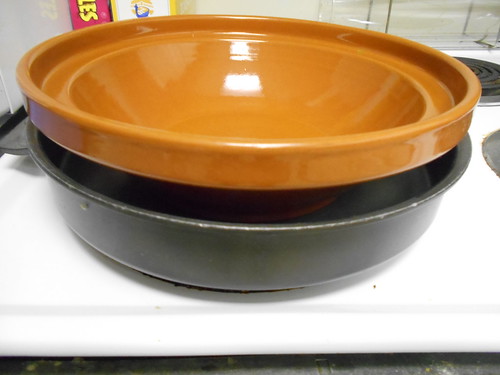
I set the stove for medium-high heat, and when the oil was ready I added some of the chicken:

It started to sizzle, and we were in business! I was cooking in a tagine! Everything was going so well!
And then the kitchen rang with the sharp sound of the tagine cracking.
Approximately one second later it rang with the sharp sound of my swearing.
I removed it from the heat immediately and scooped out the chicken to double check. Maybe it was just some oil popping or something?
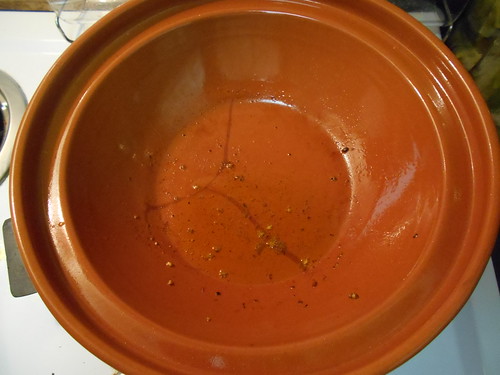
Nope. Cracked tagine.
Now I had the problem of a bowl of raw marinated chicken, a bowl of onions, and a bowl of fresh herbs, olives, and sliced preserved lemon peel to contend with. Thinking quickly, I threw away the onions because onions are disgusting and I had no use for them in my repurposed dinner. I would have omitted them to begin with but figured they were adding liquid to the tagine chicken by cooking down in the pot, and I didn't want it to dry out. Then I pulled out a skillet, tossed in the chicken and the quarter cup of lemon juice that was supposed to go in the tagine, and started browning the chicken. When it was mostly done I dumped in the other bowl and let it simmer for a few minutes:

while I made the couscous. So, I didn't get to make delicious tagine chicken, but I did make delicious Moroccan spiced chicken instead, and ate it with couscous with golden raisins:
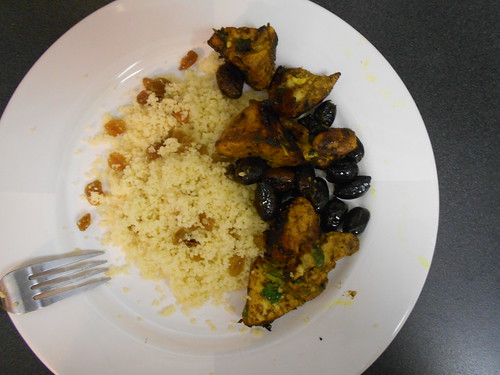
Too bad about the tagine exploding.

Actually, Aunt May, I think that one was all me.
2 comments:
Thanks to you, and Aunt May, and her freakishly large hands, I may need therapy.
P.S. Whether you buy a tagine online or purchase one in Morocco, it should be "seasoned" before its first use to both strengthen it and, if unglazed, remove a raw clay taste. The same procedure applies to other types of clay cookware such as the tangia.
Before you start, make sure that what you have is indeed clay or ceramic cookware and not a decorative serving piece.
Soak the lid and the base in water for at least 2 hours, or overnight. As some clay cookware is quite large, you may need to get creative. Use a large bucket, a bathtub, a sink, a laundry room wash basin, a plastic basin. If you can't find something large enough to accommodate the top of a tagine, invert the tagine lid and fill it with water instead.
Drain the water and dry the tagine (or other clay cookware). If the cookware is unglazed, rub the interior and exterior of the lid and base with olive oil.
Place the tagine or other clay cookware in a cold oven. Turn the oven on to 300° F (150° C), and set the timer for 2 hours.
After 2 hours, turn off the oven, and leave the tagine to cool completely in the oven. Wash the cooled tagine by hand, and coat the interior with olive oil before storing or using.
Authentic Moroccan clay and ceramic tagines will crack if subjected to high heat. (The same applies to other types of clay cookware.) Unless otherwise directed, use a low burner setting or an oven temperature of no more than 325° F (160° C), and wait patiently for the tagine to reach a simmer. Heat diffusers are recommended for cooking on a burner.
Tagines and other clay cookware may also crack if subjected to rapid changes in temperature. Avoid this by not adding cold food or liquids to a hot tagine, and by taking care not to place a hot tagine on a cold surface.
Similarly, don't add hot liquids to a cold tagine, or place a cold tagine in a preheated oven.
Hand wash your tagine with very mild soap, baking soda or vinegar, and rinse well. Leave the tagine to dry thoroughly, and then lightly coat the interior of the lid and base with olive oil before storing.
It's a good idea to store your tagine with the lid slightly ajar so that air can circulate. I find that glazed ceramic tagines have a tendency to mold, and this will help prevent that. If the interior does develop a little mold, simply wash the tagine and lightly coat it with olive oil before using.
Some darkening or staining should be expected with use of a tagine; this is a desirable characteristic.
According to Moroccan cookbook author Paula Wolfert, you can speed up this darkening by "curing" the tagine instead of just seasoning it. This can be done by rubbing ashes along with oil on the tagine, and then leaving the tagine in a slow oven for eight hours or longer. Sounds messy, but the tagine should take on a beautiful, aged look.
Tangines sounds a bit high maintenance. Also, since when is Aunt May part Orangutan?
Post a Comment